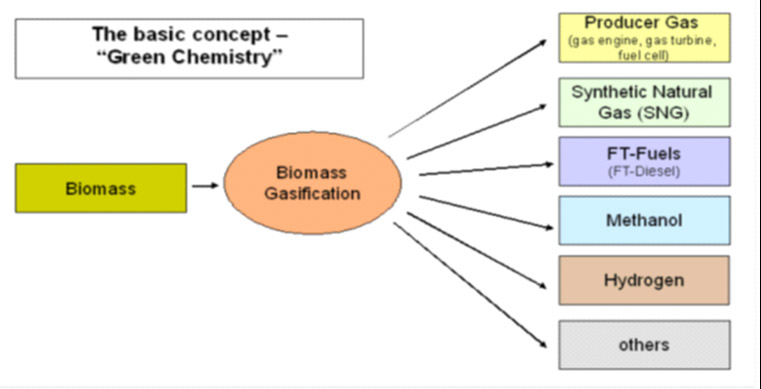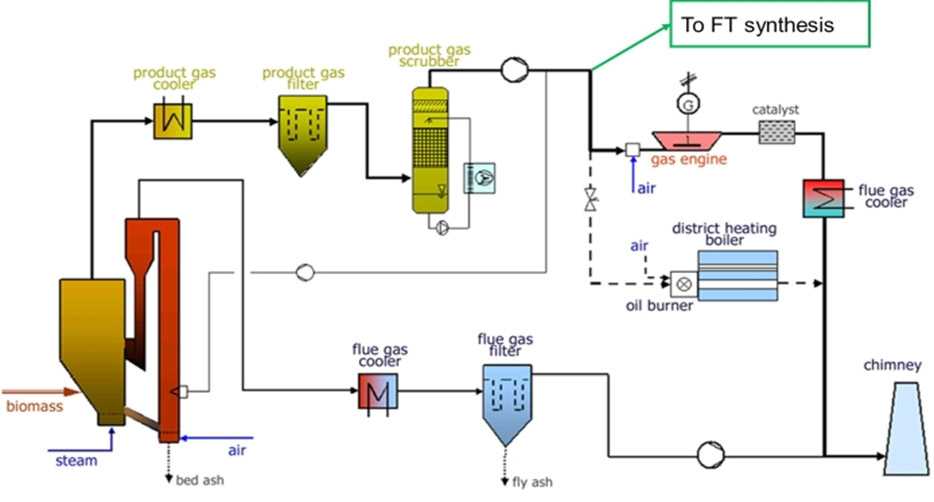Technology

Biomass power plant Fluidized bed gasification (thermal gasification)
In the biomass power plant, a new type of power plant will be realized for the first time in order to enable power generation from biomass in small decentralized power plants. In this case, a gasification process is used, which offers advantages over combustion processes, especially when used as a combined heat and power. In the biomass power plant, for example, 2,360 kg of wood generates 2,000 kWh of electricity per hour and 4,500 kWh of district heating.

New type of power plant – in future steam gasification instead of combustion
The heart of the plant, the fluidized-bed steam gasifier, consists of two interconnected fluidized bed systems. In the gasification section, the biomass is gasified at about 850 ° C with the supply of steam.
By use Water vapor instead of air as a gasification medium produces a nitrogen-free, low-tarry product gas with a high calorific value. Part of the remaining coke is transported into the combustion part via the circulating bed material (sand), which acts as a heat transfer medium. The heat dissipated to the bed material is needed to maintain the gasification reactions. The flue gas is diverted separately, whereby the contained heat is used for the decoupling of district heating.

When growing energy crops for the production of hydrogen, there is an almost closed material cycle. All the minerals that the plant has absorbed are returned to the field as easily usable ashes.
20 t of dry biomass produce approx. 2.7 t of hydrogen, which contains all the energy from the biomass. The non-combustible components can be completely returned to the ground as ash. Unlike incineration, the ash is not vitrified. So it can be well absorbed by the plants.
The gasification plants create a way to detoxify the soil. The fine dust content contains, according to experience, almost all unpopular heavy metal salts. So it makes sense to deposit about 5{9df7fce40bd81af38768f748b7bd1f30e71090474b11609fd316cac35002a35b} of the ashes or to supply them to metallurgical recycling.
CO2 and O2 (oxygen) also have a closed material cycle. As we have seriously disrupted the carbon footprint over the last 200 years, we should strive to restore the former balance. Because CO2 accumulates in concentrated form, this is easily possible without significant effort.

Most of the water brought by the wet biomass is released by the gasification plant. However, this small amount can not make a substantial contribution to irrigation. The water that is generated by the use of hydrogen, gets locally into the water cycle. Since this water has the quality of distilled water, it can also be used in the home. The average yield is one bucket of water per day.
The structure of a solar energy economy based on biomass is essentially already there. It is the natural gas network that can be converted back to hydrogen. The leakages of 0.1{9df7fce40bd81af38768f748b7bd1f30e71090474b11609fd316cac35002a35b} are not greater for hydrogen but smaller (0.04{9df7fce40bd81af38768f748b7bd1f30e71090474b11609fd316cac35002a35b}). The network is the link between the regional hydrogen factories and the consumer. The hydrogen factories get the biomass from the adjacent fields within 5-15 km. The use of hydrogen is extremely decentralized with fuel cells in every home and every vehicle. Unlike electricity, the generation of secondary energy (hydrogen) does not have to be consumed at the same time. The pipeline network and the large underground caverns act as energy storage. The biomass is also easy to store, dry or moist as silage.
In industrial plants of 50-500 MW practically all the energy of the biomass is transferred to the hydrogen. Since there is no waste heat, the most important reason for „small / small“ is eliminated. For purifying and transporting the hydrogen, only pressurized equipment is competitive. Only these systems fit into a hydrogen infrastructure. This is the only way to achieve a total energy chain efficiency of almost 100{9df7fce40bd81af38768f748b7bd1f30e71090474b11609fd316cac35002a35b}. The fluidized bed reactor shown below is standard for industrial plants. In it also wet biomass such as silage can be gassed. The ash goes back to the field as a fertilizer, because it is not vitreous.
